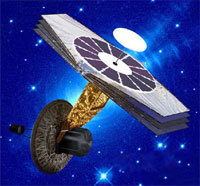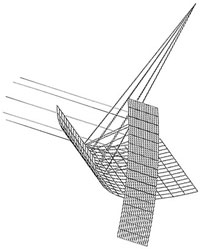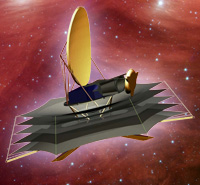Cryogenic infrared astronomy from space has seen steady development since the
Infrared Astronomical Satellite
(
IRAS)
days of 1980s.
COBE
and
ISO
have followed on in the last two decades, and the next decade will provide
Spitzer,
SPICA,
JWST
(formerly NGST),
Herschel
and
Planck.
Each new mission builds on technology and experience derived from prior missions,
and adds new technologies. These can include everything from system-wide concepts
developed for other space applications to new instrumentation and detectors developed
for the mission but proven in ground-based or airborne astronomy applications.
In this tradition, each of SAFIR's key technical areas will rely heavily on the
experience of the JWST, Herschel, Planck, and SPICA missions, but will also
incorporate new technologies that are expected to be developed over the next
decade. One
potential mission concept
for SAFIR based on the current incarnation of the JWST, developed by Goddard Space
Flight Center, was presented to the scientific community early in this decade. This
concept led to the SAFIR Vision Mission study, which encouraged refinement of many
key technology requirements that would be common to any implementation of SAFIR,
and the science cases as well. The new CALISTO architecture for SAFIR, developed
by JPL, relies on many of these same enabling technologies.
Key enabling technologies envisioned for SAFIR include:
-
a large cryogenic telescope which can be launched in a folded configuration and deployed in space
-
a reliable cooling system which can extract heat at around 4 K and radiate it into space to facilitate a long mission life
-
large-format, high-sensitivity detector arrays for wavelengths from 40 Ám to 1 mm
The state of the art and the prospects for future development in these areas are described below.
A Large Cryogenic Telescope
To fully realize the benefit of the low background noise that is possible in space at far-IR and
submillimeter wavelengths, the telescope mirror must be cooled to below about 5 K (5 degrees
Celsius above absolute zero, equal to -451°F), much lower than the 30-60 K possible with
systems that rely on passively radiating their heat into space. The dramatic gains provided by
a cold telescope are shown here.
Actively cooling a large mirror is challenging because it requires careful thermal design and
either a large amount of stored cryogen such as liquid helium, or a reliable closed-cycle cooling
system like a refrigerator. This is one of the reasons (along with much lower budgets) that the
IRAS, COBE, and ISO missions had primary mirrors less than one meter in diameter, much smaller
than the optical astronomer's counterpart, the 2.4 meter Hubble Space Telescope (infrared
emissions from "warm" telescope mirrors don't interfere with observations at optical wavelengths).
Future missions will push toward larger sizes and lower temperatures, but SAFIR's 5-10 m scale,
5 K primary mirror will be a large step beyond all currently-planned missions.
A telescope with a primary aperture larger than a few meters requires a structure that can be
folded for launch inside a protective housing a few meters in diameter, and then deployed when
in space. Also, because the structures are so large, they must have a low mass-to-area ratio to
make them lightweight enough to launch, and easy to deploy and maneuver in space.
At present, there are three promising architectures for large single aperture far infrared
telescopes that have been evaluated. A particularly innovative concept called the Dual
Anamorphic Reflector Telescope (DART) with reflecting surfaces made of unrollable sheets,
was first proposed a decade ago. Such a telescope requires a good understanding of how to
deploy such sheets in a controlled manner. A more conventional telescope with a segmented
primary mirror, similar to JWST, was the basis for the SAFIR Vision Mission study carried
out in 2004. This segmented mirror telescope represents a challenge, primarily in the deployment
and alignment of the multiple segments. This technology is undergoing extensive study for two
key NASA missions, the Terrestrial Planet Finder
(
TPF)
and JWST. A third concept, just developed, calls for a single substrate slot-shaped primary
mirror sized to fit in an EELV launch shroud. This CALISTO architecture offers a total primary
aperture that is smaller than the other two architectures, but with vastly simpler deployment
requirements and some significant performance advantages. These three options are discussed below.


A SAFIR concept based on the segmented-mirror technology to be employed for the JWST
developed by Goddard Space Flight Center. The telescope (in the lower left) would be
composed of several mirror segments. Multiple layers of shielding would block the sun's
heat and allow the cryocoolers to keep the telescope at a temperature of 4 K. The 2004
Vision Mission version of SAFIR analyzed this option.
|
The JWST will be built by TRW and Ball Aerospace and is slated to have a
six-meter telescope
composed of seven segments. For the telescope to function well, the segments must be aligned to within
about 1/10 of the mission's target wavelength of 1 µm. And because the telescope will cool
passively to around 35 K, all the mechanisms which accomplish this precise alignment must operate
at cryogenic temperatures.
Even more ambitious are concepts for the TPF mission -- one of which calls for a 28-meter primary mirror
made of 36 segments. Each of the segments must be deployed, then positioned with an accuracy of around
one micron to provide good performance in the mid-IR.
While the development of this technology with the work on JWST and TPF is encouraging for such
a SAFIR, the deployment of such a telescope is similarly quite complex, resulting in risk and
cost. Furthermore, the conventional on-axis optical design and segmented primary results in
substantial diffraction of bright sources, such as the galactic plane, into the beam at long
wavelengths, thus adding to the radiative background.


|
The DART concept is dramatically lighter in weight and potentially simpler to deploy than
segmented mirror systems. Where a conventional telescope uses a single parabolic mirror,
DART uses two ultralight reflectors made of membranes stretched on a rigid frame. Each of
these mirrors is shaped like the concave side of a pipe that has been split in half
lengthwise -- that is, it has curvature only in one direction instead of two. Though
not yet proven in an astronomical context, initial testing of a 1.2 meter prototype has
been very encouraging. For more information on the DART concept, see
Dragovan (2002).


A SAFIR architecture concept called CALISTO is a promising new concept for the mission. This
concept was developed by JPL. The primary mirror (at top) feeds the beam to an off axis secondary,
(lower right) where it is directed into the scientific instrument package through a cold baffle
structure. This arrangement strongly suppresses diffracted light that would otherwise compromise
observations just outside the galactic plane.
|
The new CALISTO architecture is a novel design that the SAFIR team is now evaluating. CALISTO uses
a 4x6 m single-substrate elliptical primary mirror, and feeds an off-axis secondary that is deployed
on-orbit with a single extendable arm. The dimensions of this telescope are chosen to fit an existing
EELV launch shroud, such that the deployment involves precisely one action. Such a simple deployment
mechanism greatly reduces the cost and risk compared with a more heavily folded design. The single
substrate mirror does not require the precision coalignment that a segmented design would involve.
Optical alignment involves moving a single mirror, the secondary, rather than a large set. The lack
of empty gaps between segments, and the off axis design that puts both the secondary and secondary
support structure out of the beam, makes for a much cleaner beam than a conventional on-axis segmented
telescope. At these long wavelengths, in which the galactic plane is enormously bright, such diffraction
effects that would dramatically increase the background level for observations of extragalactic
observations outside the plane, and such a design probably offers sensitivity advantages, even though
the primary mirror aperture might not be as large as the segmented design. CALISTO is an architecture
that provides the darkest possible sky background for the highly sensitive detectors in the focal plane.
Much as for the other SAFIR architectures, the entire CALISTO telescope would be largely passively
cooled using multilayer radiation shields, with additional cooling provided by closed cycle coolers.
The optical performance of the cryogenic primary is more easily assured with a single substrate than
with a complicated backframe that would be used to support segments.
Another key aspect to deploying a large cold telescope is the orbit. A cold telescope must be
shielded from the radiation of both the sun and the earth. For earth-orbiting systems, the angle
between the earth and sun can vary, and is typically around 90 degrees. Any cryogenic mission in
earth orbit, therefore, needs shielding in at least two directions. Typically for such missions the
telescope is mostly enclosed in radiation shields, open to space only in the direction that the
telescope is pointing.
Unfortunately, large telescopes such as the JWST and SAFIR are too large to fully enclose, so it's
desirable to place them in an orbit for which the sun and earth are in the same direction as viewed
by the spacecraft. The
Sun-Earth L2 orbit provides this. On a
line from the sun to the earth, and continuing a million miles beyond earth's orbit, the L2 point is
a relatively stable position for which the earth and sun are always on the same line, allowing
multiple flat layers of shielding on only one side of the telescope.
As missions become larger, L2 orbits are becoming more attractive. They're planned for the JWST and
Herschel missions, among a number of others. An L2 orbit will be critical for meeting the cryogenic
challenges of SAFIR; fortunately, there will be plenty of experience with launches to and station-keeping
at L2 by the time SAFIR flies.
Cryocooler Technology
To operate a large cryogenic telescope in a mission which lasts a few years, SAFIR is best served
with a closed-cycle refrigeration system instead of a large vessel of stored cryogen. Several NASA
missions have used cryocoolers over the last decade, and systems achieving temperatures around 50 K
are well-proven.
Recently NASA's Advanced Cryocooler Technology Development Program (ACTDP) was created to fund
further development of cryogenic systems for space, in part to prepare for the JWST, TPF, and
Con-X missions which require temperatures in the 4-10 K range. To see a detailed report on the
program and its three industrial efforts, see the
JPL cryocooler web page.
Mid-IR detectors need to be cooled to around 6 K, and this has been the focus thus far. A single
cooler on one of these missions might be required to provide a heat lift of 20 mW at 6 K and 150 mW
at 18 K, requiring 150 W of power. Industrial studies suggest that this can be readily accomplished.
For SAFIR in a thermally stable orbit such as L2, a few of these coolers in parallel would likely
provide plenty of heat lift (~100 mW) for a telescope at 6 K. Moreover, once such coolers are
developed for TPF, the incremental cost to SAFIR will be a small fraction of the development cost.
Extension of the technology from 6 K to the 4 K ideal for SAFIR will require only modest additional
development.
Large-format far-IR / subµm arrays with background-limited sensitivity.
Sensitive detectors are the key to astronomical discovery, and the far-IR / submillimeter has been
one of the last spectral regimes for which reliable detectors have been developed. Modest-sized
photoconductor arrays for wavelengths of about 200 µm and shorter have reached a high state
of engineering and are being assembled for flight. Examples include the Ge:Ga (germanium doped
with gallium) arrays built for the
Spitzer MIPS
and under construction for
Herschel PACS.
Beyond about 200 µm, the best choice is likely to be bolometers, a technology which has
recently seen rapid development. Moore's Law-type progress has been made since the first single
bolometers were built 40 years ago. Mapping speed has doubled roughly every year, thanks to
improvements in both individual pixel sensitivity and the number of elements in each array.
In the past decade, bolometer arrays with a few hundred elements have been constructed for
ground-based submillimeter and millimeter-wave astronomy. They provide background-limited
performance (sensitivity limited only by the irreducible background noise of photons in space)
in the continuum and even for modest spectroscopic resolving power.
Technology is maturing, and it is routine now to build large numbers of predictable, reliable
detectors. Based on experience with ground-based and balloon-based instruments, SiN (silicon
nitride) micromesh "spider web" bolometer arrays are being constructed for the
SPIRE
instrument on the Herschel Space Observatory and the
HFI
instrument on Planck.
While individual detectors and their assembly into modest arrays for ground-based astronomy are
well in hand, the present state of the art can be improved in two important ways. First, the
demonstrated sensitivities are not sufficient for background-limited operation on a cold space
telescope. (For spectroscopy at a resolution of 1000, the natural astrophysical backgrounds
produce a photon NEP of 1-3 x 10
-20 W Hz
-1/2. NEP stands for Noise Equivalent
Power,and smaller numbers represent higher sensitivities. Current detectors are still about an
order of magnitude from this sensitivity requirement.
The other key limitation is the packaging. Currently, bolometer array size is limited to a few
hundred elements (about 1/1000 the number of pixels on a typical computer monitor) because each
detector is individually wired. To overcome this limitation, multiplexing schemes which wire
many pixels together as a unit are under development. The technologies are new and substantial
effort will be required in the coming years to mature the technologies for SAFIR, but the progress
is encouraging, and scientists are optimistic that swift development will continue.

